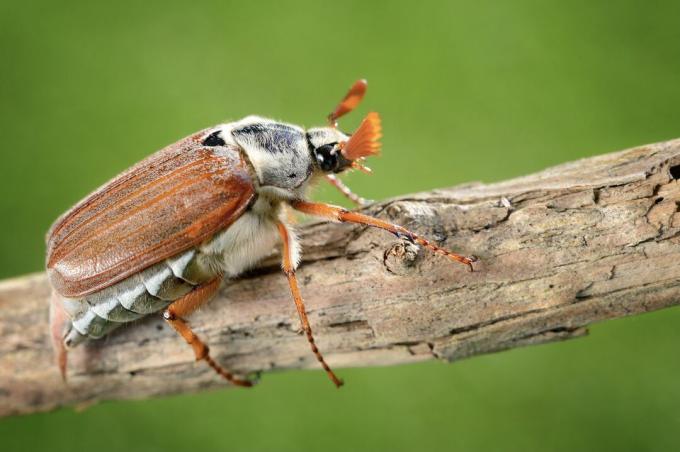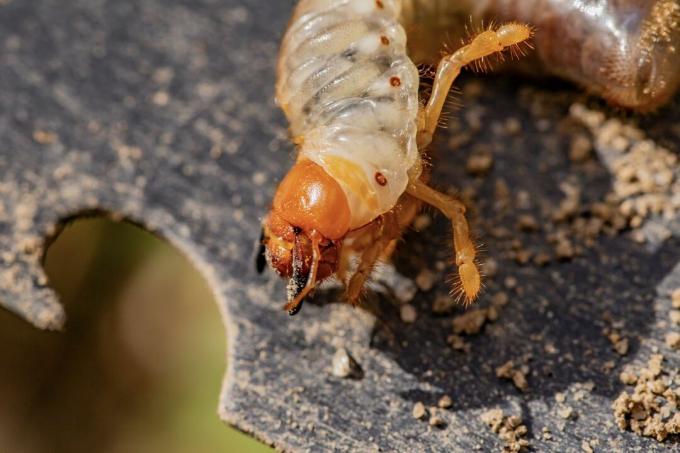Garden beetles can become unwanted residents of your garden. We will show you how to properly identify and control the garden beetle.

While beetle larvae are considered a delicacy in Vietnam, they are known as a pest in many places in Germany. This also applies to the larvae of the garden beetle, which, like the cockchafer and June beetle, belongs to the scarab beetles (Scarabaeoidea). Among other things, they feed on lawn roots and leave patchy lawns behind from July to September, which often causes irritation in sports facilities, parks and home gardens. To prevent damage, garden beetle traps and other biological means can be used.
"Contents"
- Identify garden beetles
- Should the garden beetle be fought?
-
Control garden chafer grubs with nematodes
- Which nematodes can be used against garden leaf beetles?
- Nematodes against garden beetles: timing
- Apply nematodes against garden beetles
- Use garden bug traps
- Infestation prevention: expert tips
Identify garden beetles
The garden beetle (Phyllopertha horticola) comes from the family of scarab beetles. The larvae of all scarab beetles are called grubs. To distinguish him from his relatives, such as May beetles, June beetles or Japanese beetleTo be able to distinguish, it must be recognized correctly.
You can recognize the garden beetle by these characteristics:
- Size: 8 to 11mm
- Body: Densely hairy
- Elytra: Light brown
- Pronotum: Metallic green
- Antennae: Short, ending in three lamellae
To avoid confusion with the May beetle, the June beetle and the Japanese beetle, which have become rare, you should first pay attention to the size of the beetle. The garden beetle is a lot smaller than its confounding partners. Cockchafers have a body length of about 20 to 30 millimeters, while June and Japan beetles have a length of 15 to 18 millimeters. In contrast to the garden beetle, the May beetle's body is not hairy and the feelers end in six lamellae instead of two. The Japanese beetle also has a green pronotum, but differs from the garden chafer by the white tufts of hair on the side of the body. More information about Detection, prevention and control of the June beetle can be found in this special article.

Should the garden beetle be fought?
Control of the garden beetle makes sense in exceptional cases. The garden chafer beetles feeding on the leaves of oak, birch, hazel, cherry and rose trees hardly causes any damage. Only the larvae of the garden beetle, the grubs, can damage a green lawn in individual cases. This is particularly annoying in sports facilities and on golf courses. The grubs of the garden chafer feed on lawn roots, among other things, so that the lawn becomes stunted in nests. Secondary damage caused by birds scratching at the grubs is also unfavorable for sporting activities. To prevent this damage, garden beetle traps can be used - they provide information on how many beetles fly to mate. Three weeks after the mating flight, the grubs hatch, which from mid-July migrate upwards in the ground and begin to eat the plant roots. Fighting the grubs makes sense from 100 larvae per square meter. Nematodes can be used to biologically combat the grubs of the garden chafer.
Tip: To find out how many larvae live in your lawn, you can simply cut out a piece of lawn and count from mid-July: Find in half a square meter 50 larvae or in a quarter square meter 25 larvae, you should use one of the control methods presented below Select.

Control garden chafer grubs with nematodes
Nematodes are tiny organisms that are also called roundworms or nematodes. Some genera of these nematodes parasitize beetle larvae such as grubs or the larvae of the vine weevil. They act host-specifically, so that they pose no danger to warm-blooded animals, humans and plants. Harnessing nematodes is simple and effective when used properly.
Which nematodes can be used against garden leaf beetles?
The nematode species Heterorhabditis bacteriophora, who is also ours Plantura HB nematodes belong to, penetrates specifically into the body orifices of the garden chafer grub and there secretes a bacterium that kills the grub within two to three days. After infection, the nematodes multiply against the grubs. Once the grub is eaten, the nematodes leave their host in search of a new food source.

Nematodes against garden beetles: timing
The beetle flight of the garden chafer takes place between mid-July and the end of September. About six weeks later, the nematodes are released against the grubs. The floor temperature should be at least 12 °C. As long as the nematodes find food sources, they will survive and reproduce. They die off in dry conditions, which is why the soil should always be kept moist.
Tip: Since nematodes can only be stored for a limited time, they should only be ordered shortly before use and used quickly. Upon receipt are ours Plantura HB nematodes Unopened, it can be kept in the fridge for about six weeks.
Apply nematodes against garden beetles
The application of nematodes against garden chafer grubs is fairly straightforward, but a number of important factors should be considered. Since the roundworms are sensitive to UV radiation, it is advisable to apply them in the evening hours or when the sky is overcast. For this purpose, a stock suspension is first prepared by adding the powdered nematodes to a little water according to the enclosed instructions and stirring them. Portions of this stock suspension are stirred into the water and distributed - this results in several watering cans full of nematode suspension. In the case of very small areas and quantities, the preparation of a stock suspension can be omitted. Either a conventional watering can or a nematode sprayer can be used for application. The nematode suspension should be applied completely. An overdose has no adverse effect.
The remaining nematodes attached to the blades of grass can then be flushed into the soil with two to five liters of water per square meter. In dry weather this should be done within 30 minutes as nematodes do not survive drought. It is also important to keep the soil moist at all times for the next six weeks.
Summary: Use nematodes against garden leaf beetles
- Choose the right time to apply the nematodes: July to September, soil temperature at least 12 °C.
- Mix nematodes with water according to the instructions and dilute further if necessary.
- Apply nematode suspension in the evening hours.
- Keep soil moist for the next six weeks.

Use garden bug traps
Garden chafer traps are used to monitor the adult garden chafer population. They are equipped with attractants that are distributed with the help of the wind. Male and female garden chafers fly against a yellow baffle and fall into a funnel. From mid-May, the traps can be set up or hung outdoors. The attractant has a range of 100 square meters and can be renewed separately every year.
Important: If the funnel is filled within a very short time, nematodes should definitely be released this year to reduce the spread of the garden chafer. Because garden beetle traps are not effective methods of combating them, they only serve to monitor the beetle's flight.
Infestation prevention: expert tips
Ensure a dense lawn and good watering, because female garden beetles prefer sandy soil and dry lawns to lay their eggs. As your Proper lawn care all year round, you can find out in our suitable special article. During the flight of the beetles in May, the lawn should be mowed a little higher, which reduces the appearance of the larvae by 40 to 70%. Those who like to plant can replace lawns with vegetable or flower beds. When creating a new garden, care can also be taken to ensure that not too many host plants of the To plant garden chafers - especially if the occurrence of the garden chafer in your own region anyway is frequent.
The host plants of the garden beetle include:
- birches
- hazels
- apple trees
- poplars
- pear trees
- oak trees
- roses
- pastures
- mountain ash
Incidentally, moles and birds are natural opponents in your own garden. As a preventive measure, you can also manually collect adult garden chafers from flowers and leaves or set up garden chafer traps.

Conclusion: In exceptional cases, grubs of the garden chafer can damage the lawn. To prevent a heavy infestation, garden beetle traps can be set up and a dense turf can be promoted. However, if biological control of the garden leaf beetle is necessary, nematodes can be used. If you have more Identify grubs of beetles yourself want, our further article will help you.
